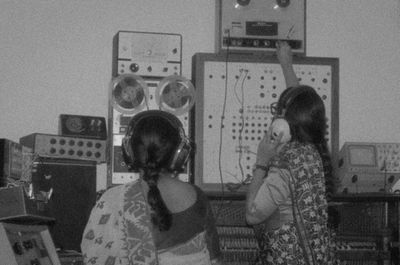Difference between revisions of "FSMR"
(→History) |
|||
| (7 intermediate revisions by one user not shown) | |||
| Line 1: | Line 1: | ||
| − | [[File:FSMR000.jpeg|right|400px|FSMR]] | + | [[File:FSMR000.jpeg|right|thumb|400px|Researchers at FSMR]] |
== FSMR == | == FSMR == | ||
| Line 6: | Line 6: | ||
'''FSMR''' ('''F'''undamental '''S'''ystems '''M'''usic '''R'''esearch) was a center for [[experimental musical instrument|research and development of new musical instruments]] in the electronic performing arts, located in [[Bangalore]], [INDIA]]. It was a center for research in Indian [[Electronic music]] and [[Computer Music]]. The group began its operations in 1976. | '''FSMR''' ('''F'''undamental '''S'''ystems '''M'''usic '''R'''esearch) was a center for [[experimental musical instrument|research and development of new musical instruments]] in the electronic performing arts, located in [[Bangalore]], [INDIA]]. It was a center for research in Indian [[Electronic music]] and [[Computer Music]]. The group began its operations in 1976. | ||
| − | == | + | == History == |
| + | FSMR began in 1976. It was founded by physists, composers and computer scientists most of whom were involved in building the TIRFAC, the first Indian computer. <ref>Inspired by the visits of John Cage, David Tudor and other American composers to India</ref>, FSMR's experiments were built on combining Hindustani and Carnatic music with Electronics and Computers. A revolving array of composers and sound engineers worked at the FSMR. | ||
| + | 3 volumes of selected music were released as quadrophonic records. | ||
| + | <ref>Scandals about the groups funding and internal discord caused the laboratory to shut-down in the mid eighties.</ref> | ||
| − | + | <ref>{{cite interview |last=Roy |first=Arundhati |interviewer1=Damodaran, Vinita|interviewer2=Padel, Felix|interviewer3=Das, Samarendra |title=Burning Ground: Mining, Adivasis and India's Civil War |type=Forum |url=http://www.soas.ac.uk/gallery/disappearingworld/05jun2011-burning-ground-mining-adivasis-and-indias-civil-war.html |work=Brunei Gallery |location=London |date=2011-06-05 |accessdate=2011-07-19}}</ref> | |
| − | + | ||
| − | |||
| − | + | Scandals about the groups funding and internal discord caused the laboratory to shut-down in the mid eighties.<ref>''Modern Art as a C.I.A weapon"</ref> | |
| + | This is reference 1.<ref name="refname1" /> | ||
| + | This is reference 2.<ref name="refname2" /> | ||
| + | ==References== | ||
| + | {{Reflist|refs= | ||
| + | <ref name="refname1">content1</ref> | ||
| + | <ref name="refname2">content2</ref> | ||
| + | }} | ||
| + | |||
| + | |||
| + | Markup Renders as | ||
| + | This is page content.<ref>''LibreOffice For Starters'', First Edition, Flexible Minds, Manchester, 2002, p. 18</ref> | ||
| + | {{reflist}} | ||
| + | |||
| + | == Research == | ||
The FSMR built one of the first synthesizers - the APSARA. Inspired by a visit to an Italian concert of Electronic music. The synthesizer featured a keyboard optimised to play microtones and Indian Scales. | The FSMR built one of the first synthesizers - the APSARA. Inspired by a visit to an Italian concert of Electronic music. The synthesizer featured a keyboard optimised to play microtones and Indian Scales. | ||
| Line 23: | Line 38: | ||
== Music == | == Music == | ||
| − | Recordings of the work created at the Laboratory were released and are currently being digitized. | + | Recordings of the work created at the Laboratory were released and are currently being digitized. Composers working at FSMR released one of the first quadrophinic records in India. |
| + | == Notes== | ||
| + | {{Reflist}} | ||
== References == | == References == | ||
| + | |||
[https://eastofborneo.org/articles/subcontinental-synth-david-tudor-and-the-first-moog-in-india/ Subcontinental Synth: David Tudor and the First Moog in India] | [https://eastofborneo.org/articles/subcontinental-synth-david-tudor-and-the-first-moog-in-india/ Subcontinental Synth: David Tudor and the First Moog in India] | ||
| + | |||
| + | [https://www.independent.co.uk/news/world/modern-art-was-cia-weapon-1578808.html Modern art is a CIA weapon] | ||
| + | |||
| + | {{reflist|refs= | ||
| + | <ref name=name1>Content</ref> | ||
| + | <ref name=name2>Content</ref> | ||
| + | <ref name=name...n>Content</ref> | ||
| + | }} | ||
Latest revision as of 17:39, 2 November 2017
FSMR
FSMR (Fundamental Systems Music Research) was a center for research and development of new musical instruments in the electronic performing arts, located in Bangalore, [INDIA]]. It was a center for research in Indian Electronic music and Computer Music. The group began its operations in 1976.
History
FSMR began in 1976. It was founded by physists, composers and computer scientists most of whom were involved in building the TIRFAC, the first Indian computer. <ref>Inspired by the visits of John Cage, David Tudor and other American composers to India</ref>, FSMR's experiments were built on combining Hindustani and Carnatic music with Electronics and Computers. A revolving array of composers and sound engineers worked at the FSMR.
3 volumes of selected music were released as quadrophonic records.
<ref>Scandals about the groups funding and internal discord caused the laboratory to shut-down in the mid eighties.</ref>
<ref>Template:Cite interview</ref>
Scandals about the groups funding and internal discord caused the laboratory to shut-down in the mid eighties.<ref>Modern Art as a C.I.A weapon"</ref>
This is reference 1.<ref name="refname1" /> This is reference 2.<ref name="refname2" />
References
Markup Renders as
This is page content.<ref>LibreOffice For Starters, First Edition, Flexible Minds, Manchester, 2002, p. 18</ref>
Template:Reflist
Research
The FSMR built one of the first synthesizers - the APSARA. Inspired by a visit to an Italian concert of Electronic music. The synthesizer featured a keyboard optimised to play microtones and Indian Scales.
Music
Recordings of the work created at the Laboratory were released and are currently being digitized. Composers working at FSMR released one of the first quadrophinic records in India.
Notes
References
Subcontinental Synth: David Tudor and the First Moog in India
